 Subaru Legacy 2023 Loading your vehicle Touring XT
Subaru Legacy 2023 Loading your vehicle Touring XT
The 2023 Subaru Legacy Touring XT has an adaptable loading capacity to meet a range of transport requirements. It has a roomy trunk that can hold up to 15.1 cubic feet of stuff, which is more than enough space for luggage, groceries, and daily necessities. Conveniently folding the rear seats into a 60/40 split configuration allows you to accommodate larger or longer things in the cargo compartment while still leaving room for passengers. If installed, roof rails provide even more carrying options for large items or freight carriers. Because of Subaru’s dedication to functionality and adaptability, the Legacy Touring XT is a trustworthy option for both shorter trips and daily errands. It can adjust to your cargo requirements.
2024 Subaru Legacy Specs, Price, Features, Mileage (Brochure)
Loading your vehicle
WARNING
- Never allow passengers to ride on a folded rear seatback in the cargo area. Doing so may result in serious injury.
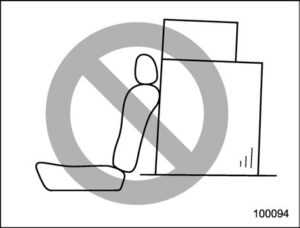
- Never stack luggage or other cargo higher than the top of the seatback because it could tumble forward and injure passengers in the event of a sudden stop or accident. Keep luggage or cargo low, as close to the floor as possible.
- When you carry something inside the vehicle, secure it whenever you can to prevent it from being thrown around inside the vehicle during sudden stops, sharp turns or in an accident.
- Do not pile heavy loads on the roof. These loads raise the vehicle’s center of gravity and make it more prone to tip over.
- Secure long items properly to prevent them from shooting forward and causing serious injury during a sudden stop.
- Never exceed the maximum load limit. If you do, some parts on your vehicle can break, or it can change the way your vehicle handles. This could result in loss of control and cause personal injury. Also, overloading can shorten the life of your vehicle.
- Do not place anything on the rear shelf behind the rear seatback (Legacy) or the extended cargo area cover (Outback – if equipped). Such items could tumble forward in the event of a sudden stop or a collision. This could cause serious injury.
CAUTION
Do not carry spray cans, containers with flammable or corrosive liquids or any other dangerous items inside the vehicle.
NOTE
For better fuel economy, do not carry unneeded cargo.
Vehicle capacity weight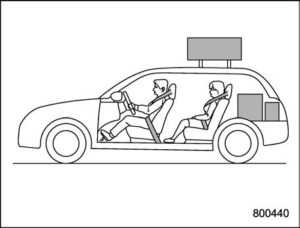

Vehicle placard
The load capacity of your vehicle is determined by weight, not by available cargo space. The maximum load you can carry in your vehicle is shown on the vehicle placard attached to the driver’s side door pillar. It includes the total weight of the driver and all passengers and their belongings, any optional equipment such as a trailer hitch, roof rack or bike carrier, etc., and the tongue load of a trailer.
GVWR and GAWR (Gross Vehicle Weight Rating and Gross Axle Weight Rating)
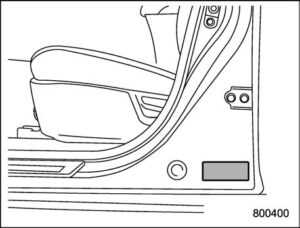
Certification label
The certification label attached to the bottom of the driver’s side door pillar shows GVWR (Gross Vehicle Weight Rating) and GAWR (Gross Axle Weight Rating). The GVW (Gross Vehicle Weight) must never exceed the GVWR. GVW is the combined total of weight of the vehicle, fuel, driver, all passengers, luggage, any optional equipment, and trailer tongue load. Therefore, the GVW changes depending on the situation. The GVWR equals Curb Weight (actual weight of your vehicle – including standard equipment, fluids, emergency tools and spare tire assembly) plus the vehicle capacity weight. In addition, the total weight applied to each axle (GAW) must never exceed the GAWR. The front and rear GAWs can be adjusted by relocating luggage inside the vehicle. Even if the total weight of your luggage is lower than the vehicle capacity weight, either front or rear GAW may exceed the GAWR, depending on the distribution of the luggage. When possible, the load should be evenly distributed throughout the vehicle. If you carry heavy loads in the vehicle, you should confirm that GVW and front and rear GAWs are within the GVWR and GAWR by putting your vehicle on a vehicle scale, found at a commercial weighing station.
Do not use replacement tires with a lower load range than the originals because they may lower the GVWR and GAWR limitations. Replacement tires with a higher load range than the originals do not increase the GVWR and GAWR limitations.
Roof rails (if equipped)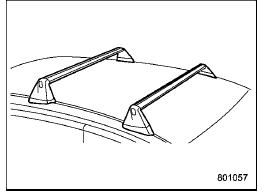
CAUTION
- For cargo-carrying purposes, the roof molding must be used together with a roof crossbar kit and the appropriate carrying attachment.
- Otherwise, damage to the roof or paint or a road hazard due to loss of cargo could result.
- When using the roof crossbar kit, make sure that the total weight of the crossbars, carrying attachment and cargo does not exceed the maximum load limit. Overloading may cause damage to the vehicle and create a safety hazard.
- Do not install a roof tent on the vehicle. Doing so may damage the vehicle and create a safety hazard. SUBARU warranties do not cover vehicle damage resulting from use of a roof tent.
Cargo can be carried after securing the roof crossbar kit to the roof molding and installing the appropriate carrying attachment. When installing the roof crossbar kit, follow the manufacturer’s instructions.
When carrying cargo on the roof using the roof crossbar kit and carrying attachments, never exceed the maximum load limit as explained below. You should also be careful that the vehicle does not exceed the Gross Vehicle Weight Rating (GVWR) and front and rear Gross Axle Weight Rating (GAWR). The maximum total load on the roof (including crossbars, carrying attachments, and cargo) must not exceed 88 lbs (40 kg). Refer to the crossbar installation instructions for the maximum crossbar capacity. Place the heaviest load at the bottom, close to the roof, and evenly distribute the cargo. Always properly secure all cargo.
Installing carrying attachments on the crossbars
When installing any carrying attachments such as load carriers, crossbars, bike carriers, ski carriers, kayak carriers, cargo baskets, etc., follow the manufacturer’s instructions for the load capacity and make sure that the attachments are securely installed. Use only attachments designed specifically for the crossbars. Before operating the vehicle, make sure that the cargo is properly secured on the attachment.
NOTE
Remember that the vehicle’s center of gravity is altered with the weight of the load on the roof, thus affecting the driving characteristics.
Drive carefully. Avoid rapid starts, hard cornering, and abrupt stops. Crosswind effects will be increased.
Removal and installation of the crossbars
Each of the two roof moldings has two mounting points for crossbars. Each mounting point is fitted with a cover. Use a screwdriver to open the covers. When installing the crossbars on the roof molding, follow the manufacturer €™s instructions.
Roof Rails with Integrated Crossbars (Outback)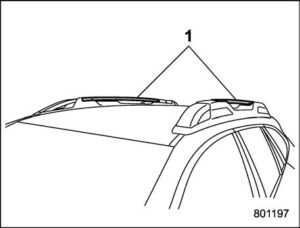
Integrated crossbars
CAUTION
- For cargo-carrying purposes, the crossbars must be extended across the roof and locked into the roof rails. Cargo must be attached to the crossbars using genuine SUBARU accessory crossbar attachments. The crossbars must never be used independently to carry cargo on the roof. Otherwise, damage to the roof or paint or a dangerous road hazard due to loss of cargo could result.
- When loading cargo on the crossbars, using the genuine SUBARU accessory crossbar attachments, make sure the total weight of the crossbar attachments, and loaded cargo, does not exceed the maximum load limit of 150 lbs (67.5 kg). Overloading may cause damage to the vehicle and create a safety hazard.
- Be careful not to damage the vehicle’s body when passing the rope through the front and rear holes of the roof rails.
- Do not install a roof tent on the vehicle. Doing so may damage the vehicle and create a safety hazard. SUBARU warranties do not cover vehicle damage resulting from the use of a roof tent.
The crossbars must be extended across the roof and locked into the roof rails to carry cargo on the roof. Cargo can only be carried on the crossbars using the genuine SUBARU accessory crossbar attachments.
When you carry cargo on the roof using the crossbars and a carrying attachment, never exceed the maximum load limit explained in the following. You should also be careful that your vehicle does not exceed the Gross Vehicle Weight Rating (GVWR) and front and rear Gross Axle Weight Rating (GAWR). The maximum load limit of the cargo and carrying attachment must not exceed the allowable load limit described in the Owner’s Manual of a genuine SUBARU carrying attachment. Place the heaviest load at the bottom, nearest the roof, and evenly distribute the cargo. Always properly secure all cargo.
Installing carrying attachments on the crossbars
When installing any carrying attachments such as load carriers, crossbars, bike carriers, ski carriers, kayak carriers, cargo baskets, etc., follow the manufacturer’s instructions of the load capacity and make sure that the attachments are securely installed. Use only attachments designed specifically for the crossbars. Before operating the vehicle, make sure that the cargo is properly secured on the attachment.
NOTE
- Remember that the vehicle’s center of gravity is altered with the weight of the load on the roof, thus affecting the driving characteristics. Drive carefully, and avoid rapid starts, hard cornering, and abrupt stops. Crosswind effects will be increased.
- Restore the bars to the original position when the bars are not used as crossbars.
How to use as crossbars
- Do not raise the bar higher than necessary. The base of the bar may be damaged.
- Be careful not to contact the bars while sliding them. Otherwise, the bars may be scratched or the latch portions may be damaged.
- Do not allow the bar to fall on or contact the roof panel or the moonroof when sliding the bar. Otherwise, the roof panel may be dented or the glass of the moon-roof may be damaged.
- Be careful hands do not become pinched when operating the crossbar. Hands becoming pinched could result in injury.
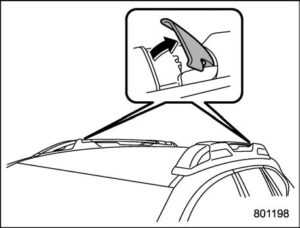
- Pull out the integrated crossbars from the roof rail holders by pulling up the covers.
- Slide the bars in the direction shown in the illustration.
- Install the bars into the holders.
- Make sure that the latches are fitted securely.
How to change the position of the crossbar
Carefully read the warning label attached to the roof rail.
You can change the position of the rear crossbar. To change the position, perform the following procedure.
- Take out the torque wrench from the under-floor storage compartment.
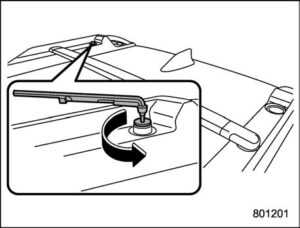
- Remove the plastic plug of the roof rail holder by using the torque wrench.

- Remove the bolt of the crossbar by using the torque wrench and pull this side out.
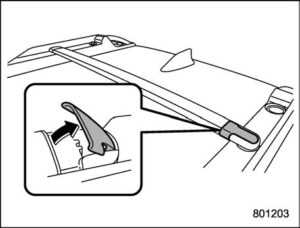
- Pull out the other side of the crossbar from the roof rail holder by pulling up the cover.
- Install both ends of the crossbar into the other holders.
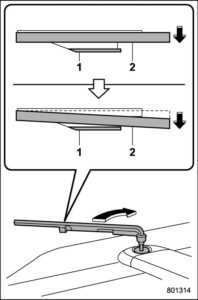
- Guide plate
- Torque wrench
- Using the torque wrench, tighten the crossbar bolts until the torque wrench hits the guide plate.
NOTE
The tightening torque is approximately 8.9 + 2.2 lbf·ft (12 + 3.0 N·m, 1.2 + 0.3 kgf·m).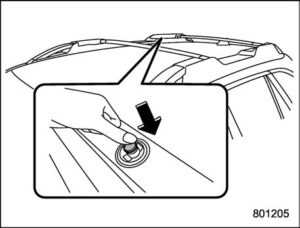
- Install the plastic plug by pushing it into the hole until it is fully seated.
How to re-stow bars
Do not use the bars as roof rails when the bars are stowed.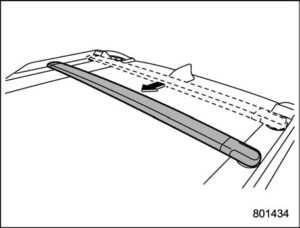
- Check that the rear crossbar is stowed in the front side holder. If the rear crossbar is stowed in the rear side holder, move it back to the front side holder (original position).

- Pull out the crossbars from the roof rail holders by pulling up the covers.
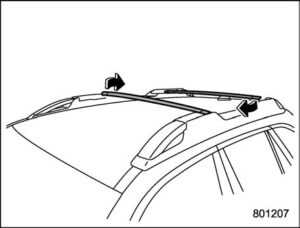
- Slide the bars in the direction shown in the illustration.

- Install the bars into the holders.
- Make sure that the latches are fitted securely.
Roof Rails with Ladder Type (Subaru Outback Wilderness)
Roof rails
Cargo can be carried on the roof after securing the roof crossbars to the roof rails and installing the appropriate carrying attachments. When installing the roof crossbars and the carrying attachments, follow the manufacturer’s instructions. The roof rail system is designed to carry loads (cargo, roof crossbars and carrying attachments) of no more than 220 lbs (100 kg). Be sure not to exceed your vehicle’s GVWR and GAWR.
CAUTION
- When using the carrying attachments, make sure that the total carrying load of the cargo, roof crossbars, and carrying attachments does not exceed 220 lbs (100 kg). Overloading may cause damage to the vehicle. Read the manufacturer’s instructions and pay attention to not exceeding the load limit of the parts.
- For cargo-carrying purposes, the roof rails must be used together with the SUBARU recommended roof crossbars and any appropriate carrying attachment that may be needed. The roof rails must never be used alone to carry cargo. Otherwise, damage to the roof or paint, or a dangerous road hazard due to loss of cargo could result.
NOTE
Remember that the vehicle’s center of gravity is altered with the weight of the load on the roof, thus affecting driving characteristics.
Drive carefully. Avoid rapid starts, hard cornering and abrupt stops. Crosswind effects will be increased.
Rope hooks (attached to the roof rails)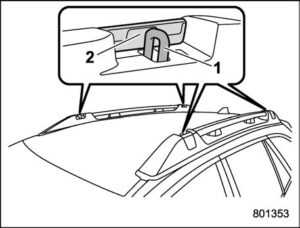
- Rope hooks
- Covers
CAUTION
- When you use the rope hooks, always secure the rope at all four hook points.
- The maximum load capacity is 176 lbs (80 kg) per hook.
- The cover cannot be removed. . Do not tighten the rope excessively. Otherwise, it may lead to damage to the vehicle body or cargo
- Check that the rope is not loose before driving the vehicle.
- When you use the rope hooks, never exceed the maximum load limit.
Roof Tent (Subaru Outback Wilderness)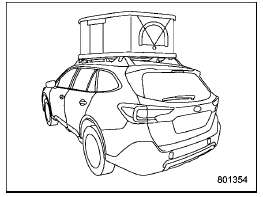
WARNING
Adding weight to the vehicle’s roof can adversely affect the handling, braking, and rollover resistance. The vehicle must never be driven with a total roof rail load in excess of 220 lbs (100 kg).
CAUTION
- The roof rail load limit for stationary vehicles (700 lbs (317 kg)) applies only when the vehicle is parked and the load is evenly distributed left/right and front/rear and the roof crossbars and roof tent are tightly secured to the vehicle. If these conditions are not met, the load limit will be lower.
- The maximum load limit of the roof crossbars must be obtained from the manufacturer or retailer of the roof rack. When driving the vehicle, the maximum roof rail load is 220 lbs (100 kg) or the crossbar load limit (whichever is lower).
Roof tents may be used under certain conditions at your own risk.
- When driving the vehicle
The total weight on the roof rails, including the roof crossbars and roof tent, must not exceed the vehicle roof rail load of 220 lbs (100 kg), evenly distributed.

- Roof rails
- Roof crossbars
- Roof tent
B + C < 220 lbs (100 kg)
When the vehicle is parked on level ground
- Roof rails
- Roof crossbars
- Roof tent
- Occupants in the roof tent
The total weight on the roof rails –including the roof crossbars, roof tent, and all occupants and contents in the roof tent – must not exceed either the vehicle’s roof rail load limit (700 lbs (317 kg)), evenly distributed or the load limit of the roof crossbars, whichever is lower.
The load limit of the roof rail (A). B + C + D < 700 lbs (317 kg)
Exceeding this load limit could cause damage to the vehicle or racking system. The vehicle must never be driven with occupants in the roof tent. Before the vehicle is driven, occupants and cargo must be removed from the roof tent and the roof rail load must be restored to within the roof rail load limit of 220 lbs (100 kg). Refer to the user manual that accompanied the roof tent for important safety information and instructions on the proper installation and use of the tent.
Trailer Hitch (Outback/Subaru Outback Wilderness –If Equipped)
- Never exceed the maximum weight specified for the trailer hitch. Exceeding the maximum weight could cause an accident resulting in serious personal injuries. Permissible trailer weight changes depending on the situation.
- Never drill the frame or under-body of your vehicle to install a commercial trailer hitch. If you do, dangerous exhaust gas, water or mud may enter the passenger compartment through the drilled hole. Exhaust gas contains carbon monoxide, a colorless and odorless gas that is dangerous, or even lethal if inhaled. Also, drilling the frame or underbody of your vehicle could cause deterioration of the strength of your vehicle and cause corrosion around the drilled hole.
- Be sure your trailer has safety chains and that each chain will hold the trailer’s maximum gross weight. Towing trailers without safety chains could create a traffic safety hazard if the trailer separates from the hitch due to coupling damage or hitch ball damage.
- Use only a ball mount that is suitable for the trailer hitch. Use the hitch only as a weight-carrying hitch. Do not use any type of weight-distributing hitch.
- The standard bumper beam must be installed after you remove the trailer hitch. Consult a SUBARU dealer for the purchase of a standard bumper beam if you do not have the original.
- If a trailer hitch is installed, it is not possible to install the rear towing hook.
CAUTION
Do not modify the vehicle exhaust system, brake system, or other systems when installing a hitch or other trailer towing equipment.
When any of the tires are punctured, you can seal the tire temporarily. However, do not tow a trailer when a sealed tire is used. We recommend that you consult the nearest SUBARU dealer for details. The maximum gross trailer weight and maximum gross tongue weight are indicated in the following table.
| Maximum gross trailer weight | Maximum gross tongue weight | |
| 2.4 L models |
3,500 lbs (1,588 kg) |
350 lbs (159 kg) |
| 2.5 L models |
2,700 lbs (1,224 kg) |
270 lbs (122 kg) |
Connecting a SUBARU Genuine Trailer Hitch
- Remove the receiver cover from the hitch receiver tube. Then insert the ball mount into the hitch receiver tube.
- Insert the hitch pin into the hole located on the hitch receiver tube so that the pin passes through the ball mount.
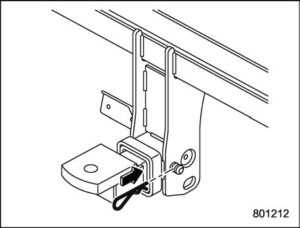
- Insert the safety pin through the provided hole on the hitch pin securely.
- Check the ball mount assembly by pulling on it to make sure it does not come off the hitch receiver.
- Hitch ball installation point
- Hooks for safety chains
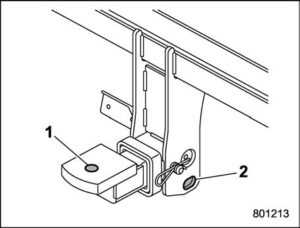
- Use only a hitch ball that is appropriate for the ball mount and your trailer. The hitch ball must be securely installed on the ball mount.
- Connect your trailer to the hitch ball.
- Connect the trailer and the hitch with safety chains that will hold the trailer’s maximum gross weight. In case the trailer hitch connector or hitch ball should break or become disconnected, the trailer could get loose and create a traffic safety hazard. For safety, always connect the towing vehicle and trailer with trailer safety chains. Two chains should be used in total, one to the right side and the other to the left side trailer tongue. Pass the chains crossing each other under the trailer tongue to prevent the trailer from dropping onto the ground in case the trailer tongue disconnects from the hitch ball. Allow sufficient slack in the chains taking tight turn situations into account; however, be careful not to let them drag on the ground.
WARNING- For safety, always connect the towing vehicle and trailer with safety chains.
- Do not connect safety chains to any part of the vehicle other than the safety chain hooks.
- Be sure to check the hitch pin and safety pin for positive locking placement before towing a trailer. If the ball mount comes off the hitch receiver, the trailer could get loose and create a traffic safety hazard.
 Hitch harness connector
Hitch harness connector
- Connect the hitch wire harness’s black four-pin wire connector to the towing trailer’s wire harness.
- Confirm proper function of the hitch wire harness by individually activating the brake, stop and turn signal lights on the trailer.
NOTE
- A genuine SUBARU hitch is available from your SUBARU dealer.
- Always disconnect the trailer wire harness before launching or retrieving a watercraft.
If Not Towing a Trailer
The housing should be kept clean at the points of contact. The surfaces only require cleaning with a cloth. Grease or other lubricants should never be used.
- Remove the ball mount from the hitch receiver tube and insert the receiver cover onto the hitch receiver tube.
- Place the dust cap over the four-pin connector of the hitch wire harness to protect against possible damage.
- Occasionally lubricate the terminals of the four-pin connector using terminal grease.
FAQ
The Legacy Touring XT typically offers a trunk capacity of around 15.1 cubic feet (428 liters).
Cargo capacity remains relatively consistent across Legacy trims, with minor variations based on optional equipment.
The rear seats can be folded down in a 60/40 split to expand the cargo area and accommodate longer items while maintaining passenger seating.
Subaru typically provides a maximum cargo weight rating in the owner’s manual; it’s essential not to exceed this limit to maintain vehicle safety and performance.
Distributing weight evenly and securing heavy items to prevent shifting is essential to maintain vehicle stability.
Some Legacy models may have a compact spare tire or a tire repair kit in the trunk, allowing for additional cargo space.
The roof rail weight limit, if available, is typically mentioned in the owner’s manual or on the vehicle’s specifications.
Subaru provides guidelines for roof load capacity to ensure safe and stable transport of rooftop cargo carriers or accessories.
The Legacy Touring XT is not typically designed for towing heavy trailers, and its towing capacity may be limited. Refer to the owner’s manual for specific details.
Distributing weight evenly and securing items to prevent movement is crucial to maintaining vehicle balance during long drives.
Subaru offers various cargo accessories such as cargo trays, organizers, and cargo nets to help keep the trunk organized and items secure.
Some models may include a compact spare tire or a tire repair kit, ensuring preparedness for unexpected tire issues.
The vehicle’s trunk is typically weather-sealed to protect cargo from moisture, but using cargo mats or organizers can add an extra layer of protection.
Yes, many Legacy models come equipped with a cargo cover or offer it as an optional accessory for added privacy and security.
With the rear seats folded down and the appropriate accessories, the Legacy Touring XT can transport longer items like skis or bicycles.
Useful Link
View Full User Guide: Subaru Legacy 2023 Touring XT User Guide
Download Manuals: https://www.subaru.com/owners/vehicle-resources/manuals.html
2024 Subaru Legacy Specs, Price, Features, Mileage (Brochure)

